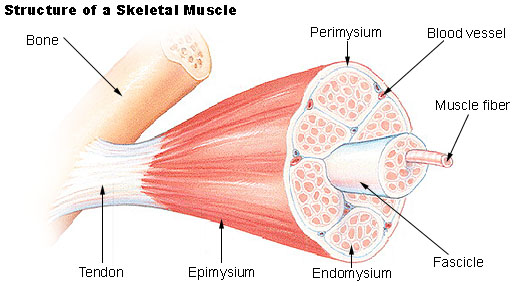You are here
An Oft Overlooked Cause of Joint Pain
When people ask me about Achilles tendon or wrist pain, one of the first things I do is evaluate the muscles higher up that lead to the site of pain.
In the case of Achilles tendonitis, I test the calf muscles (gastrocnemius and soleus) for length and presence of adhesions, and in the case of wrist pain, I check the forearm flexors and extensors closer to their origin near the elbow joint.
When a muscle group is chronically tight because of overuse, injury, and lack of stretching, this impedes blood flow to its tendons, which makes these tendons highly susceptible to injury from accumulation of waste products and workload from everyday activities.
 If you look at a cross section of a large muscle group, you'll see three different layers of connective tissue that compartmentalize individual muscle fibers and groups of muscle fibers (fascicles). Out toward the ends of a muscle group, muscle tissue diminishes, and these three layers of connection tissue - called your epimysium, perimysium, and endomysium - come together to become your tendons, which insert into your bones. Where these connective tissue layers are adjacent to large amounts of muscle tissue around the middle of a large muscle group, they are well perfused with blood, as muscle tissue is highly vascularized by blood vessels that run in between bundles of muscle fascicles. But out toward the tendons where muscle tissue disappears, there are fewer blood vessels. So when muscles are tight, less blood travels through the vessels that run in between muscle fascicles, which means less overall blood supply for tendons, which don't receive a lot of blood to begin with.
If you look at a cross section of a large muscle group, you'll see three different layers of connective tissue that compartmentalize individual muscle fibers and groups of muscle fibers (fascicles). Out toward the ends of a muscle group, muscle tissue diminishes, and these three layers of connection tissue - called your epimysium, perimysium, and endomysium - come together to become your tendons, which insert into your bones. Where these connective tissue layers are adjacent to large amounts of muscle tissue around the middle of a large muscle group, they are well perfused with blood, as muscle tissue is highly vascularized by blood vessels that run in between bundles of muscle fascicles. But out toward the tendons where muscle tissue disappears, there are fewer blood vessels. So when muscles are tight, less blood travels through the vessels that run in between muscle fascicles, which means less overall blood supply for tendons, which don't receive a lot of blood to begin with.
The take-home message is that in order for tendons around joints like your wrists, ankles, knees, and hips to stay healthy, the muscles that become those tendons cannot be chronically tight. Regular stretching and pressure work via massage therapy or foam rolling are effective therapies to prevent muscles from shortening over time, which helps keep tendons healthy via optimal blood flow.
For guidance on how to do this with the forearm muscles that become the tendons that control your wrist, have a look here:
How To Keep Your Wrists Healthy
And here is a post on how to ensure that tight calf muscles aren't contributing to Achilles tendonitis:
How to Prevent Achilles Tendonitis
This isn't to say that wrist, ankle, and other joint pain can't be caused by an issue right at the site of pain. A good practitioner will help identify root causes of pain and how to address all contributing causes, including any tight muscles that feed their tendons into the area where pain is felt.
For people who stretch and foam roll regularly and still experience regular sprains and strains, I typically test for vitamin D deficiency, which is a common cause of poor connective tissue health and often an underlying root cause of aches and pains associated with fibromyalgia.






